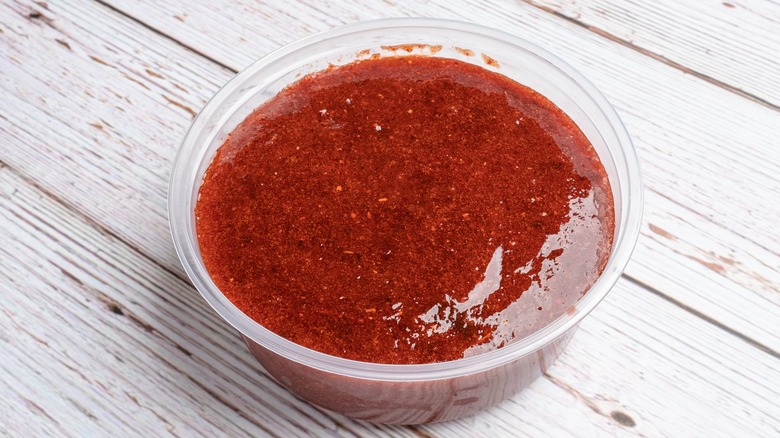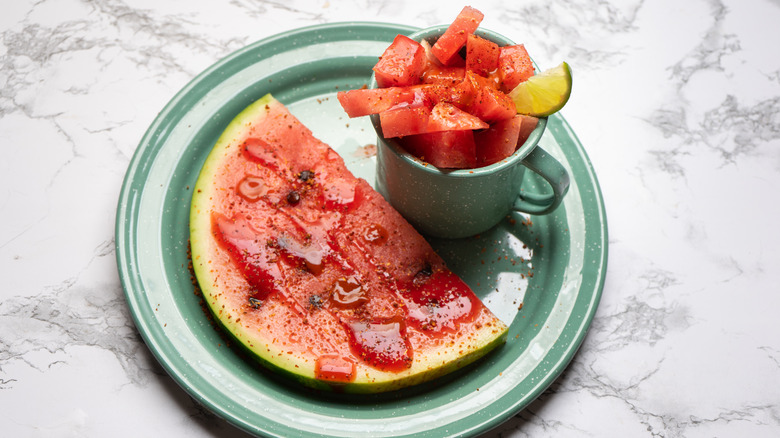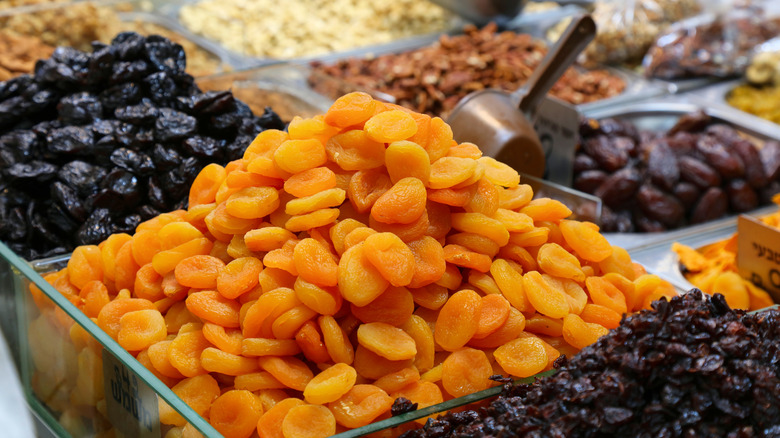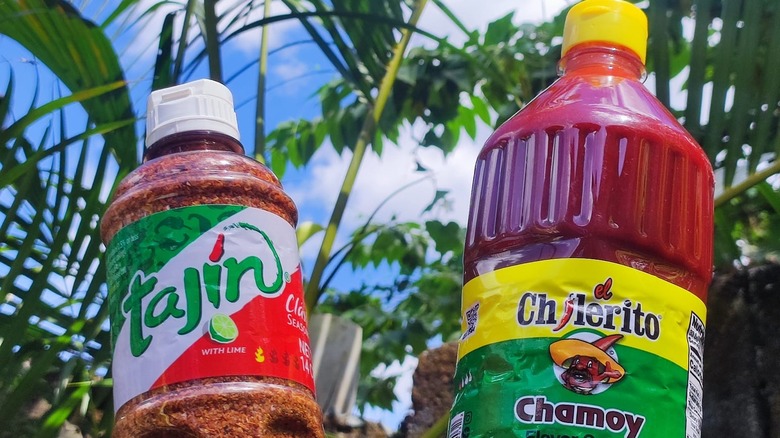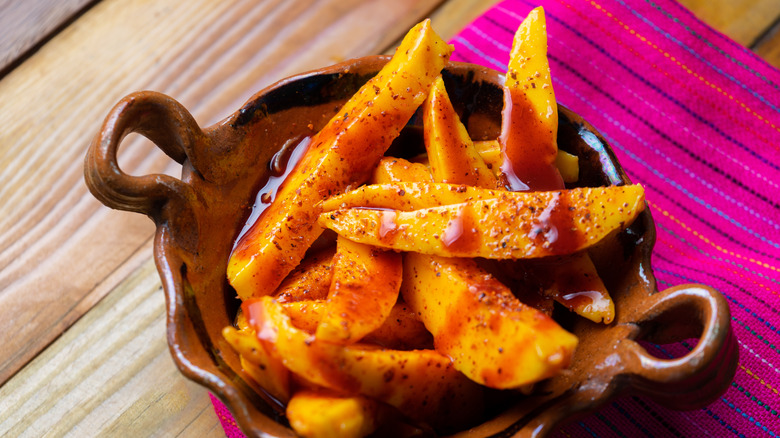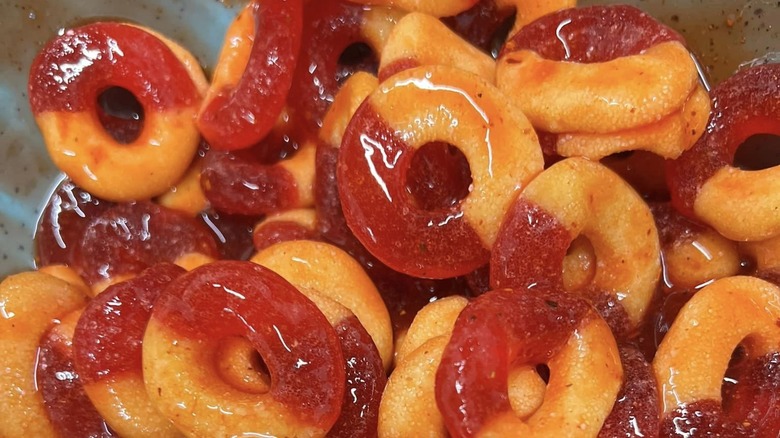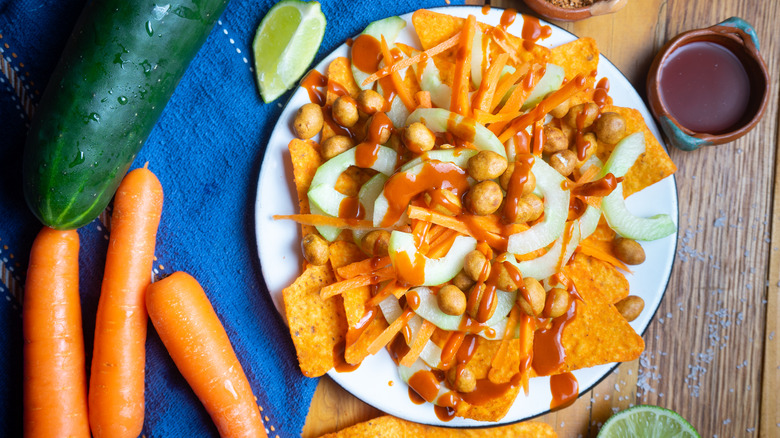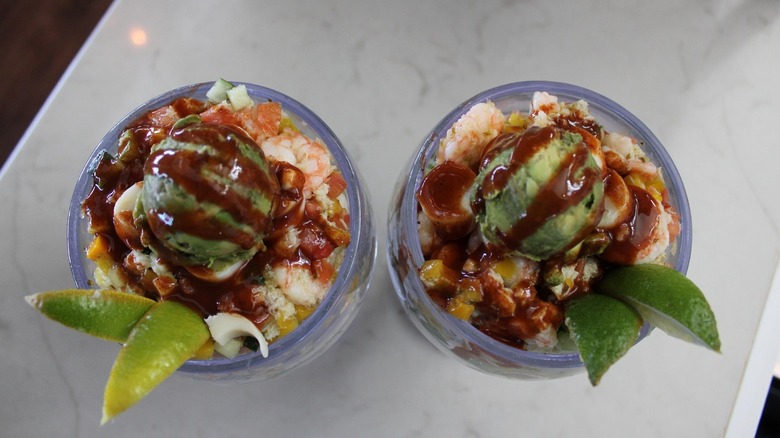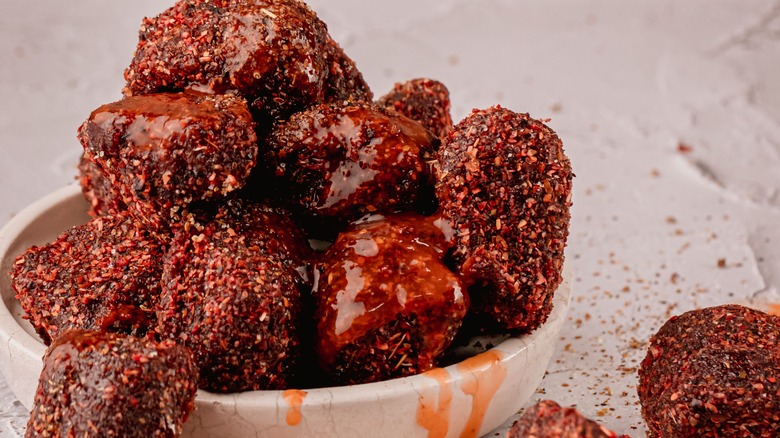What Is Chamoy And How Do You Cook With It?
We may receive a commission on purchases made from links.
With a mouthwatering balance of sweet, sour, spicy, and salty flavors, chamoy is one of the most delicious condiments, traditionally found in Mexican cuisine. Made from a blend of dried fruits and mild chilies, chamoy can be eaten as a glossy red sauce, a dried paste, or a seasoning powder. You may have seen caramel apples coated with chamoy or seen it drizzled over tropical fruits like watermelon, mango, or pineapple.
Chamoy's stimulating flavor makes it versatile, helping it pair well with a wide range of sweet and savory foods. It can be used to cut fatty dishes, like cheesy nachos or meat tacos, and can also be served over ice cream or enhance the sour flavors in gummy sweets.
You can even incorporate chamoy into a range of cocktails and Mexican drinks. It's almost impossible not to feel creative in the kitchen when using it. To better understand this shapeshifting ingredient, we've gathered all the necessary information to help you when cooking with chamoy.
What is chamoy?
Chamoy is a Mexican fruit-based sauce or paste used primarily as a condiment or seasoning. It is similar to Indian chutney, however, unlike many chutneys, chamoy has a smooth, pureed texture and does not contain fruit chunks. While it is used widely in Mexican cuisine, chamoy is believed to have originated in Asia and traveled to South America with Chinese immigrants. It is closely related to Chinese salted fruit snacks or see mui – usually dried and salted apricots — and to Japanese umeboshi plum preserve.
Chamoy is also similar to crack seed, Hawaii's favorite snack, which are believed to stem from the same Chinese sour plum recipes and fruit-preserving techniques. Chamoy has a distinctive dark red hue drawn from the natural fruit colorings, the red chilies, and the addition of dried hibiscus flowers and Tajin powder, commonly found in most processed and homemade chamoy recipes. Chamoy sauce texture is moderately thick and runny, similar to hot sauce, while the paste is sticky and pliable, almost like a moist cake frosting.
How is chamoy made?
Despite its mysterious reputation, chamoy is easy to make at home and has a fairly straightforward and pleasantly flexible recipe. The sauce is started by boiling dried apricots, prunes, red chilies, and dried hibiscus or Jamaica flowers in a pan with water. You can also substitute apricots for different dried fruits if you want a different flavor. Many recipes recommend using a mixture of mild chilies, such as arbol or guajillo, and recommend removing the seeds before adding them to the pot.
You can adapt the amount or the type of chilies used to suit your spice preference. Some chamoy recipes include Mexican powder candy to enhance the tangy, sweet, and sour taste. These ingredients are boiled together and — after the fruits have softened — left to steep and cool.
From here, you will need to add sugar or honey – these ingredients can also be stirred into the water as you bring it to a boil — and several spoonfuls of Tajin powder. This dried chili mix has a salty flavor and gives the sauce an additional kick. After this, the chamoy sauce is blended until smooth and finished with salt and lime juice. These final ingredients can also be adjusted to taste depending on how briny or how sour you like your chamoy.
Chamoy vs. Tajin
Although it is often used similarly to chamoy — sprinkled over fresh fruit or used to add citrusy tang and chili heat to savory dishes — Tajin powder and chamoy are distinct Mexican seasonings. Chamoy is a unique ingredient because of its complex flavor balance, which combines sweetness, sourness, and spice. Tajin, in contrast, is a popular lime and chili powder made by the brand Tajin, and its dominant flavors are sourness and heat. Like chamoy, Tajin is also salty and often contains crushed sea salt.
Unlike chamoy, Tajin does not incorporate a sweet element. It is not made with a base of dried fruits and, instead, combines powdered chilies with dehydrated lime juice. While chamoy can be found in powdered form, it is usually eaten as a pouring or dipping sauce, while Tajin generally refers to a spice powder.
Despite these differences, Tajin and chamoy are ubiquitous in Mexican cooking and reflect the complex flavor profile of South American cuisine. You can also make a version of Tajin powder at home, as you can with homemade chamoy.
What does chamoy taste like?
Chamoy has a zesty and refreshing flavor that lights up the palette with its blend of sweetness, spice, sour zing, and salt. With so much going on, the overall flavor ends up being miraculously balanced – not overly spicy and not so sour that it makes your mouth pucker. As a condiment, chamoy's job is primarily to enhance and complement the other flavors around it, which it does incredibly well. As it has fruit notes, chamoy pairs well with fresh fruit and complements its sweetness and its tanginess.
The mild heat in chamoy can bring a delicious kick to savory foods, while the tartness and sweetness can sharpen heavy or greasy flavors. And, its sweet undertone also works well with salty snacks, like French fries, tortilla chips, or Mexican tostilocos – a mix of Tostitos chips, spicy peanuts, dried candied fruit, crunchy vegetables, and crispy pork skins.
Perhaps the most seemingly unusual use for chamoy is as a dip for or a coating on gummy candies. In Western cuisine, we don't usually associate very sweet snacks with sauces we would also put on meat. However, ducles enchilados – chamoy-covered gummy candies — are extremely popular in Mexican cuisine. The lime juice and chili in chamoy enhance the juicy sourness of the sweets and give them an addictive tang.
How to cook with chamoy?
Chamoy works well in both sweet and savory dishes and stands alone as a tasty dipping sauce for chips, fresh fruit, nuts, and candies. One popular way to cook with chamoy is to use it as a marinade or glaze for meat and fish. Fatty fish, like salmon, will stand up to chamoy's strong flavors — you can brush chamoy sauce lightly onto the fish flesh before grilling or baking. You can also use the same technique to glaze pork chops – a meat that is famously enhanced by fruity flavors and one that is easy to make mistakes when cooking. Or, try adding it to your favorite fruit candy.
The smoky quality of grilled or barbequed meat balances well with chamoy's chili heat. You can also toss or marinate chicken in chamoy sauce before cooking to create delicious spicy hot wings or chicken salads with plenty of tangy bite. Chamoy candied apples are a popular Mexican dessert and are easy to make at home. These crunchy and refreshing treats can be made by dipping a whole apple into a mixture of heated sugar, cornstarch, and red food coloring and then rolling it in chamoy sauce and Tajin powder.
Where to buy chamoy?
You can buy common chamoy brands at some large grocery stores, such as Kroger and Walmart, as well as at specialized Mexican stores. In supermarkets, a 33-fluid-ounce bottle of chamoy is likely to cost you around $10. Meanwhile, from Mexican shops and candy stores, a 1-litre bottle will generally cost between $5-10. You can also purchase bottles of chamoy sauce online, through retail sites like Amazon, for roughly $24 per 33 fluid ounces.
Some Mexican candy stores sell chamoy sauce and. You can also find independent chamoy producers that sell unique versions of the sauce made from various fruits or that sell items like chamoy rim dips for drinks and chamoy-coated candy. A 7-8 ounce bundle of chamoy gummy sweets generally costs between $8-11. If you want to find chamoy-covered fruit, you will often see it for sale at street food fairs with Mexican stalls or you can even buy dried fruit that's been soaked in chamoy from Mexican stores and general health food stores.
Nutritional information about chamoy
Homemade chamoy is quite nutritionally dense because of the whole fruits and chilies it is made with. Dried fruits contain antioxidants and fiber, and prunes and apricots are high in nutrients like potassium and carotenes (vitamin A). These fruits also contain high levels of vitamin C, as does the citrus juice that's added to chamoy. However, even homemade chamoy can be quite high in sugar as dried fruits retain fructose and glucose when their natural moisture is removed, and extra sugar or sweetener is usually added to give chamoy its sweet taste.
Calorie counts and nutritional content in homemade chamoy will vary depending on the ratios used. Common brands of storebought chamoy, however, generally contain around 3-4 calories per 30-gram portion, which is about 2 tablespoons. This same quantity will contain around 1 gram of carbohydrates.
Chamoy also contains sodium due to the added salt and the salt in the Tajin powder. There is estimated to be around 440 micrograms of sodium in a 30-gram serving of storebought chamoy.
Varieties of chamoy
As well as traditional chamoy, which is usually made with apricots, you can also find a wide range of chamoy snacks and products made with different types of fruit. Common fruit variations include tamarind chamoy and pineapple chamoy. Tamarind is a sweet and sour pod fruit that grows in Africa, India, Thailand, and Mexico. Similar to chamoy sauce, tamarind paste is frequently used as a sweet and sour flavoring ingredient in Thai and South Indian cuisine.
It is also fairly common to find tamarind pods coated in traditional apricot chamoy as a tasty dried fruit snack. Mango chamoy and plum chamoy are also popular variants. Beyond the sauce, paste, and powder varieties, you can also find chamoy rim dip.
This sticky paste dip usually contains melted Pulparindo — a type of Mexican tamarind sour candy — and is used on the tops of drink cans or to put on the rim of cocktail glasses, but if you do this make sure you're using the right glass. It can even be smeared on the rims of certain beer bottles, such as Corona, which works well with zesty lime flavors.
How to store chamoy
Similar to most chutneys and fruit preserves, chamoy has a relatively lengthy shelf life as long as it is kept cool and stored in a clean, airtight container. Store-bought chamoy contains preservatives so it doesn't need to be kept in the fridge. Instead, you can stash it in a cool, dry area for around 3 months with no issues. Homemade chamoy, in contrast, is made using fresh ingredients, so should be kept in the fridge and will last about 2 months in an airtight container.
You should also make sure to wipe down the container rim after each use to stop any spilled sauce from oxidizing and spoiling around the lid. Exposing fresh chamoy to the air for long periods can also change the flavor and aromas in the sauce and lead it to lose intensity. You can also freeze chamoy in sauce form and as a paste for around 6 months.
Be sure to check out the best food and drink to top with tajin and while you're at it, have a look at these Mexican candies, which you should try at least once.
